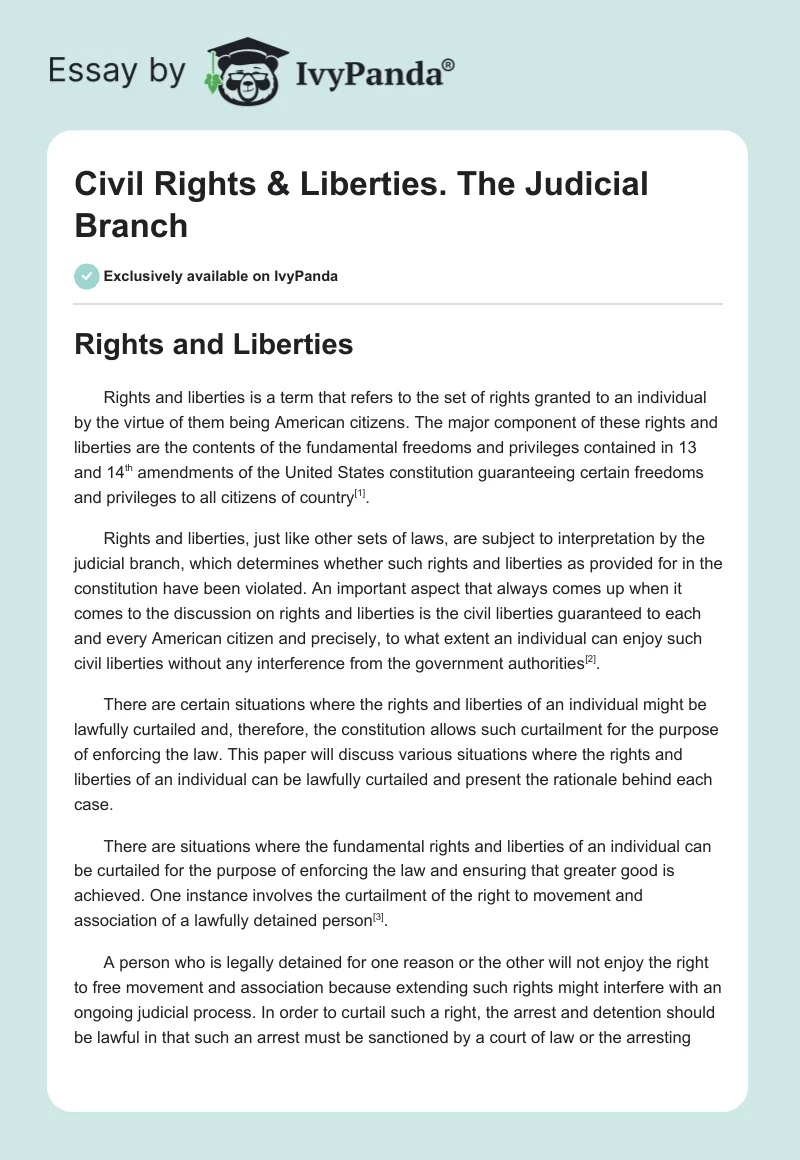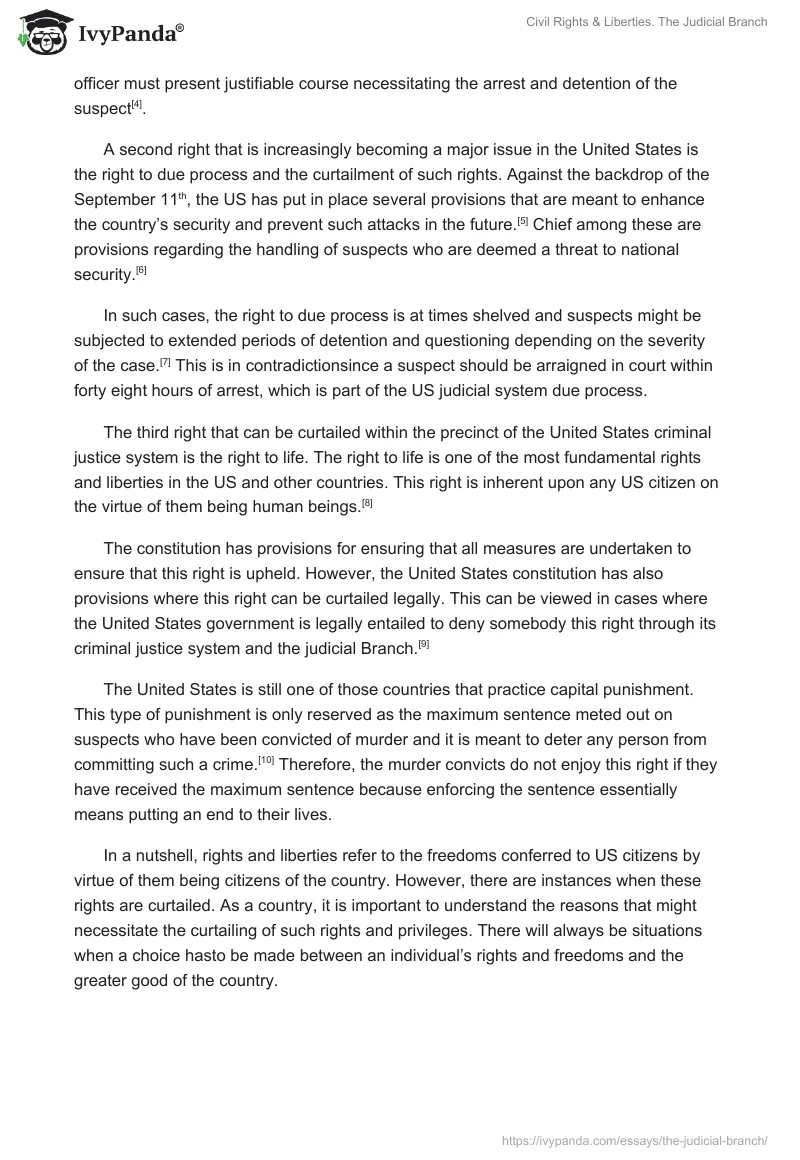Rights and Liberties
Rights and liberties is a term that refers to the set of rights granted to an individual by the virtue of them being American citizens. The major component of these rights and liberties are the contents of the fundamental freedoms and privileges contained in 13 and 14th Amendments of the United States constitution guaranteeing certain freedoms and privileges to all citizens of country.
Rights and liberties, just like other sets of laws, are subject to interpretation by the judicial branch, which determines whether such rights and liberties as provided for in the constitution have been violated. An important aspect that always comes up when it comes to the discussion on rights and liberties is the civil liberties guaranteed to each and every American citizen and precisely, to what extent an individual can enjoy such civil liberties without any interference from the government authorities.
There are certain situations where the rights and liberties of an individual might be lawfully curtailed and, therefore, the constitution allows such curtailment for the purpose of enforcing the law. This paper will discuss various situations where the rights and liberties of an individual can be lawfully curtailed and present the rationale behind each case.
There are situations where the fundamental rights and liberties of an individual can be curtailed for the purpose of enforcing the law and ensuring that greater good is achieved. One instance involves the curtailment of the right to movement and association of a lawfully detained person.
A person who is legally detained for one reason or the other will not enjoy the right to free movement and association because extending such rights might interfere with an ongoing judicial process. In order to curtail such a right, the arrest and detention should be lawful in that such an arrest must be sanctioned by a court of law or the arresting officer must present justifiable course necessitating the arrest and detention of the suspect<.
A second right that is increasingly becoming a major issue in the United States is the right to due process and the curtailment of such rights. Against the backdrop of the September 11th, the US has put in place several provisions that are meant to enhance the country’s security and prevent such attacks in the future. Chief among these are provisions regarding the handling of suspects who are deemed a threat to national security.
In such cases, the right to due process is at times shelved and suspects might be subjected to extended periods of detention and questioning depending on the severity of the case. This is in contradiction since a suspect should be arraigned in court within forty eight hours of arrest, which is part of the US judicial system due process.
The third right that can be curtailed within the precinct of the United States criminal justice system is the right to life. The right to life is one of the most fundamental rights and liberties in the US and other countries. This right is inherent upon any US citizen on the virtue of them being human beings.
The constitution has provisions for ensuring that all measures are undertaken to ensure that this right is upheld. However, the United States constitution has also provisions where this right can be curtailed legally. This can be viewed in cases where the United States government is legally entailed to deny somebody this right through its criminal justice system and the judicial Branch.
The United States is still one of those countries that practice capital punishment. This type of punishment is only reserved as the maximum sentence meted out on suspects who have been convicted of murder and it is meant to deter any person from committing such a crime. Therefore, the murder convicts do not enjoy this right if they have received the maximum sentence because enforcing the sentence essentially means putting an end to their lives.
In a nutshell, rights and liberties refer to the freedoms conferred to US citizens by virtue of them being citizens of the country. However, there are instances when these rights are curtailed. As a country, it is important to understand the reasons that might necessitate the curtailing of such rights and privileges. There will always be situations when a choice hasto be made between an individual’s rights and freedoms and the greater good of the country.
Judicial Branch
Judicial branch is a term that refers to the system of courts in all levels of government. The main responsibility of the judicial branch is interpretation of laws and applying the interpretation in the determination of cases brought before them.
The judicial branch is made up of the Supreme Court and other lower courts, which coordinate their efforts with an aim of ensuring that justice is delivered to each and every complainant through effective and correct interpretation of laws. There have been several aspects regarding the composition and structure of the judicial branch that serve to underscore the effectiveness of the Judicial Branch in both the country’s criminal justice and civil justice system.
Such aspects and structures have resulted in streamlining of the operation of the judicial branch and enhancing the ability of this vital branch in the interpretation of laws. This paper will discuss the structure and composition of the judicial branch and highlight their importance as far as the performance of the judiciary is concerned.
Starting with the Supreme Court that is the highest court of the land, it mainly deals with interpretation of the law. It interprets congressional enactments that are placed before it and in matters such as the interpretation of the law the Supreme Court’s ruling is final. Therefore, the Supreme Court is regarded as the final court of appeal. In addition to that, the Supreme Court is the only court mandated to settle international disputes that the country might be involved in.
In addition to the Supreme Court, another court that is important as far as the operations of the US Judicial System are concerned is the appellate court. The appellate court is tasked with the responsibility of determining cases originating from lower cases where there are disputes with the rulings. The appellate court normally sits to determine whether a lower court ruling is correct based on all the provisions that are supposed to be followed.
It can either affirm the ruling or overturn the ruling emanating from these lower courts. In order to carry out its function, the appellate court does not have to carry out another hearing of the case in question. Instead, the court relies on the transcript of the court proceedings from the lower court’s hearing.
The third court that will be discussed within the US judicial system is the district court. These courts are usually regarded as having original jurisdiction over the cases that they proceed over. Most of the cases that are decided within the US judicial branch are actually decided by the District Courts and, therefore, these courts are an integral part of the US justice system.
Some of the cases that are most commonly determined by the district courts include civil cases that result from the breach of various legal provisions, civil cases between two or more parties, criminal cases, and many other cases that do not fall directly under the mandate of the Supreme Courts or the appellate Courts.
All in all, the United States Judicial Branch is an important component of the US justice system. The Judicial Branch has several components that underscore its effectiveness as the main body tasked with the responsibility of interpreting and implementing the legal provisions contained in the constitution.
The highest court in the judicial system is the Supreme Court, which is tasked with the responsibility of interpreting laws and other congressional provisions. Its interpretation is final. The appellate court is responsible for hearing appeal cases emanating from lower courts while the district court is the court of original jurisdiction in many cases.
Bibliography
Abraham, Hiel J., and Perry B. Anthony. Freedom and the court: civil rights and liberties in the United States. New York: Oxford University Press, 1988.
Barron, June A., and Dienes C. Tony. Constitutional law. London: West Group, 1999.
Bermant, Gregory K., andWheeler R. Reir. “Federal Judges and the Judicial Branch: Their Independence and Accountability.”Mercer L. Rev. 46, no. 3 (1995): 835-1575.
Bollen, Kiel A. “Political rights and political liberties in nations: An evaluation of human rights measures, 1950 to 1984.” Hum. Rts. Q.8, no. 4, (1986): 567.
Burger, Wilson E. “Report on the Federal Judicial Branch-1974.”ABAJ60, no. 3 (1974): 1193.
Chong, Diel K. “How people think, reason, and feel about rights and liberties. ”American Journal of Political Science 5, no. 3 (1993): 867-899.
Engdahl, Derrick E. “Intrinsic Limits of Congress’ Power Regarding the Judicial Branch.”BYU L. Rev. 4, no. 3 (1999): 75.
Hensley, Tiel. R. and Baugh J. Anti. The Changing Supreme Court: Constitutional Rights and Liberties. New York: West Publishers, 1997.
Kurland, Pius B. Politics, the Constitution, and the Warren Court. New York: University of Chicago Press, 1970.
“U.S. History.”American History: from Pre-Columbian to the New Millennium. Web.


